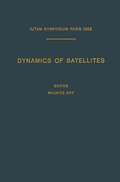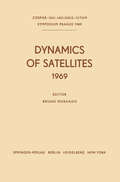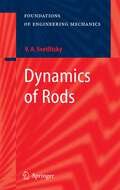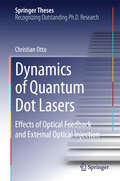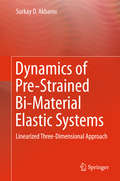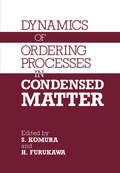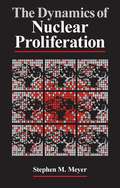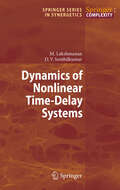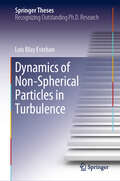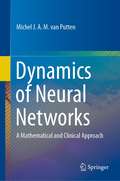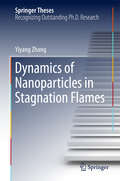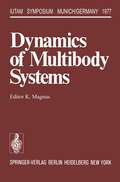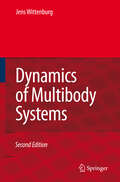- Table View
- List View
Dynamics of Saturated Electric Machines
by Vlado OstovicThis book is a result of the author's work which was initiated about a decade ago and which, in the meantime, has resulted in his Ph.D. Thesis and several technical papers. The book deals with accurate modeling of electric machines during transient and steady states, a topic which has been usually avoided in the literature. The modeling techniques herein take into account all machine peculiarities, such as the type and connection of its windings, slotting, and saturation in the iron core. A special emphasis in the book is given to the exact physical interpretation of all phenomena which influence the machine's transient behavior. Besides the Introduction, the book has five chapters. The second chapter describes basic concepts of the magnetic equivalent circuit theory and has examples of magnetic equivalent circuits of several types of machines with their node potential equations. In the third chapter the transform matrices w' and w" of A.C. wind ings are derived. These matrices playa very important role in the magnetic equivalent circuit theory because they connect the quantities from the ma chine's magnetic equivalent circuit, branch fluxes, and mmfs with the ma chine's phase currents and fluxes.
Dynamics of Satellites / Dynamique des Satellites: Symposium Paris, May 28–30, 1962 / Symposium Paris, 28–30 Mai 1962 (IUTAM Symposia)
by Maurice RoyDynamics of Satellites: Proceedings of a Symposium held in Prague, May 20–24, 1969 (IUTAM Symposia)
by Bruno MorandoThis book gathers the proceedings of a symposium on Dynamics of satellites which took place in Prague in May 1969 during the twelfth COSPAR meeting. This symposium was sponsored by the International Astronomical Union, the International Association of Geodesy, the International Union of Theoretical and Applied Mechanics and COSPAR (Committee on Space Research). The organizing committee was composed of Dr. KOVALEVSKY chair man, Dr. Yu. V. BATRAKOV representing IAU, Dr. A. H. COOK for lAG, Dr. D. KING-HELE for COSPAR, Prof. M. Roy for IUTAM and Dr. ROSENBERG. I wish to take advantage of the opportunity to thank, on behalf of all the participants, the organizing committee members, Prof. BUCHAR, Dr. RAJSK:I and Dr. SEHNAL, for the kindness and efficiency of their welcome. The interpreters who translated with virtuosity during the whole symposium also deserve our gratitude. I am grateful also for the care and skill with which Springer-Verlag has printed this volume.
Dynamics of Rotors and Foundations
by Erwin KrämerRotordynamics are of great importance in the design, manufacture and assembly of turbomachines as well as in ensuring their safe operation. Also important are the dynamics of the foundation and its interaction with the dynamics of the rotor. This book is divided into four parts. Following a presentation of the basic theory the dynamics of rotors supported on several bearings. The third part describes the dynamics of foundations of turbine line-outs and the calculations for a turbomachine coupled with its foundation. The last part includes a section on estimation procedures, a comprehensive presentation of the theoryand practice of rotors having a transverse crack, a section on the mathematical fundamentals and a description of the computer program used for the examples in the book. The book addresses both the practical engineer and the theoretician and should provide manufacturers, operators, university and polytechnic lecturers and students with an understanding of the vibrations of turbomachines. The results are described in such a way that they can be easily understood and applied.
Dynamics of Rotors: Stability and System Identification (CISM International Centre for Mechanical Sciences #273)
by O. MahrenholtzDynamics of Rotating Systems (Mechanical Engineering Series)
by Giancarlo GentaProvides an up-to-date review of rotor dynamics, dealing with basic topics as well as a number of specialized topics usually available only in journal articlesUnlike other books on rotordynamics, this treats the entire machine as a system, with the rotor as just one component
Dynamics of Rods (Foundations of Engineering Mechanics)
by Valery A. SvetlitskyThis is the first and only monograph on this subject, and provides a systematic presentation of theoretical fundamentals of the mechanics of rods as well as numerical methods used for practical purposes. Includes problems and solutions for self-study.
Dynamics of Robots with Contact Tasks (Intelligent Systems, Control and Automation: Science and Engineering #26)
by M. Vukobratovic V. Potkonjak V. MatijevicAs robots are becoming more and more sophisticated the interest in robot dynamics is increasing. Within this field, contact problems are among the most interesting, since contacts are present in almost any robot task and introduce serious complexity to system dynamics, strongly influencing robot behavior. The book formulates dynamic models of robot interaction with different kinds of environment, from pure geometrical constraints to complex dynamic environments. It provides a number of examples. Dynamic modeling is the primary interest of the book but control issues are treated as well. Because dynamics and contact control tasks are strongly related the authors also provide a brief description of relevant control issues. The book will be of interest to engineers working in research and development in robotics and automation and to both graduate and postgraduate students. The work will also be valuable to readers involved in manufacturing, robotics, automation, computer and control engineering.
Dynamics of Rigid-Flexible Robots and Multibody Systems (Intelligent Systems, Control and Automation: Science and Engineering #100)
by Paramanand Vivekanand Nandihal Ashish Mohan Subir Kumar SahaThis book discusses the dynamic analysis of rigid-flexible robots and multibody systems with serial as well as closed-loop architecture. The book presents a formulation of dynamic model of rigid-flexible robots based on the unique approach of de-coupling of natural orthogonal complements of velocity constraints. Based on this formulation, a computationally efficient and numerically stable forward dynamics algorithms for serial-chain and closed-loop robotic systems with rigid or flexible or rigid-flexible links is presented. The proposed algorithm is shown to be a numerically efficient for forward dynamics based on the investigation methodologies built on eigen value analytics. Precision and functionality of the simulation algorithms is presented/illustrated with application on different serial and closed-loop systems (both planar and spatial types). Some of the major robotic arms used to illustrate the proposed dynamic formulation and simulation algorithms are PUMA robot, Stanford robot arm, and Canadarm. It is envisaged that the book will be useful for researchers working on the development of rigid-flexible robots for use in defense, space, atomic energy, ocean exploration, and the manufacturing of biomedical equipment.
Dynamics of Quantum Dot Lasers: Effects of Optical Feedback and External Optical Injection (Springer Theses)
by Christian OttoThis thesis deals with the dynamics of state-of-the-art nanophotonic semiconductor structures, providing essential information on fundamental aspects of nonlinear dynamical systems on the one hand, and technological applications in modern telecommunication on the other. Three different complex laser structures are considered in detail: (i) a quantum-dot-based semiconductor laser under optical injection from a master laser, (ii) a quantum-dot laser with optical feedback from an external resonator, and (iii) a passively mode-locked quantum-well semiconductor laser with saturable absorber under optical feedback from an external resonator. Using a broad spectrum of methods, both numerical and analytical, this work achieves new fundamental insights into the interplay of microscopically based nonlinear laser dynamics and optical perturbations by delayed feedback and injection.
The Dynamics of Property Location: Value and the Factors which Drive the Location of Shops, Offices and Other Land Uses
by Russell SchillerWhy is property located where it is and how has this process changed in recent years? A number of factors such as social change and technological development, have affected location and these are considered. Value, the way changing patterns are measured, is examined and there is a discussion of rent contours. The book considers location in the retail industry, looking at the theory, hierarchy, clustering and dispersal. The move to out of town sites, with its three waves of decentralisation, is described. Central place theory, dating from the 1930s, is discounted as being obsolete and misleading. Finally the book covers offices, industrial and residential property.
The Dynamics of Property Location: Value and the Factors which Drive the Location of Shops, Offices and Other Land Uses
by Russell SchillerWhy is property located where it is and how has this process changed in recent years? A number of factors such as social change and technological development, have affected location and these are considered. Value, the way changing patterns are measured, is examined and there is a discussion of rent contours. The book considers location in the retail industry, looking at the theory, hierarchy, clustering and dispersal. The move to out of town sites, with its three waves of decentralisation, is described. Central place theory, dating from the 1930s, is discounted as being obsolete and misleading. Finally the book covers offices, industrial and residential property.
Dynamics of Pre-Strained Bi-Material Elastic Systems: Linearized Three-Dimensional Approach
by Surkay D. AkbarovThis book deals with dynamics of pre-stressed or pre-strained bi-material elastic systems consisting of stack of pre-stressed layers, stack of pre-stressed layers and pre-stressed half space (or half plane), stack of pre-stressed layers as well as absolute rigid foundation, pre-stressed compound solid and hollow cylinders and pre-stressed sandwich hollow cylinders. The problems considered in the book relate to the dynamics of a moving and oscillating moving load, forced vibration caused by linearly located or point located time-harmonic forces acting to the foregoing systems. Moreover, a considerable part of the book relate to the problems regarding the near surface, torsional and axisymmetric longitudinal waves propagation and dispersion in the noted above bi-material elastic systems. The book carries out the investigations within the framework of the piecewise homogeneous body model with the use of the Three-Dimensional Linearized Theory of Elastic Waves in Initially Stressed Bodies.
Dynamics of Parallel Robots: From Rigid Bodies to Flexible Elements (Mechanisms and Machine Science #35)
by Sébastien Briot Wisama KhalilThis book starts with a short recapitulation on basic concepts, common to any types of robots (serial, tree structure, parallel, etc.), that are also necessary for computation of the dynamic models of parallel robots. Then, as dynamics requires the use of geometry and kinematics, the general equations of geometric and kinematic models of parallel robots are given. After, it is explained that parallel robot dynamic models can be obtained by decomposing the real robot into two virtual systems: a tree-structure robot (equivalent to the robot legs for which all joints would be actuated) plus a free body corresponding to the platform. Thus, the dynamics of rigid tree-structure robots is analyzed and algorithms to obtain their dynamic models in the most compact form are given. The dynamic model of the real rigid parallel robot is obtained by closing the loops through the use of the Lagrange multipliers. The problem of the dynamic model degeneracy near singularities is treated and optimal trajectory planning for crossing singularities is proposed. Lastly, the approach is extended to flexible parallel robots and the algorithms for computing their symbolic model in the most compact form are given. All theoretical developments are validated through experiments.
Dynamics of Parallel Robots (Parallel Robots: Theory and Applications)
by Stefan StaicuThis book establishes recursive relations concerning kinematics and dynamics of constrained robotic systems. It uses matrix modeling to determine the connectivity conditions on the relative velocities and accelerations in order to compare two efficient energetic ways in dynamics modeling: the principle of virtual work, and the formalism of Lagrange's equations. First, a brief fundamental theory is presented on matrix mechanics of the rigid body, which is then developed in the following five chapters treating matrix kinematics of the rigid body, matrix kinematics of the composed motion, kinetics of the rigid body, dynamics of the rigid body, and analytical mechanics. By using a set of successive mobile frames, the geometrical properties and the kinematics of the vector system of velocities and accelerations for each element of the robot are analysed. The dynamics problem is solved in two energetic ways: using an approach based on the principle of virtual work and applying the formalism of Lagrange's equations of the second kind. These are shown to be useful for real-time control of the robot's evolution. Then the recursive matrix method is applied to the kinematics and dynamics analysis of five distinct case studies: planar parallel manipulators, spatial parallel robots, planetary gear trains, mobile wheeled robots and, finally, two-module hybrid parallel robots.
Dynamics of Ordering Processes in Condensed Matter
by S. KomuraThe International Symposium on Dynamics of Ordering Processes in Condensed Matter was held at the Kansai Seminar House, Kyoto, for four days, from 27 to 30 August 1987, under the auspices of the Physical Soci ety of Japan. The symposium was financially supported by the four orga nizations and 45 companies listed on other pages in this volume. We are very grateful to all of them and particularly to the greatest sponsor, the Commemorative Association for the Japan World Exposition 1970. A total Df 22 invited lectures and 48 poster presentations were given and 110 participants attended from seven nations. An objective of the Symposium was to review and extend our present understanding of the dynamics of ordering processes in condensed matters, (for example, alloys, polymers and fluids), that are brought to an un stable state by sudden change of such external parameters as temperature and pressure. A second objective, no less important, was to identify new fields of science that might be investigated by similar, but sometimes more sophisticated, concepts and tactics. An emphasis was laid on those universal aspects of the laws governing the ordering processes which transcended the detailed differences among the substances used. The 71 lectures reproduced in this volume bear witness to the success of the Symposium in meeting amply the first objective and, to a lesser extent, the second.
Dynamics of Offshore Structures
by James F. WilsonUnique, cutting-edge material on structural dynamics and natural forces for offshore structures Using the latest advances in theory and practice, Dynamics of Offshore Structures, Second Edition is extensively revised to cover all aspects of the physical forces, structural modeling, and mathematical methods necessary to effectively analyze the dynamic behavior of offshore structures. Both closed-form solutions and the Mathematica(r) software package are used in many of the up-to-date example problems to compute the deterministic and stochastic structural responses for such offshore structures as buoys; moored ships; and fixed-bottom, cable-stayed, and gravity-type platforms. Throughout the book, consideration is given to the many assumptions involved in formulating a structural model and to the natural forces encountered in the offshore environment. These analyses focus on plane motions of elastic structures with linear and nonlinear restraints, as well as motions induced by the forces of currents, winds, earthquakes, and waves, including the latest theories and information on wave mechanics. Topics addressed include multidegree of freedom linear structures, continuous system analysis (including the motion of cables and pipelines), submerged pile design, structural modal damping, fluid-structure-soil interactions, and single degree of freedom structural models that, together with plane wave loading theories, lead to deterministic or time history predictions of structural responses. These analyses are extended to statistical descriptions of both wave loading and structural motion. Dynamics of Offshore Structures, Second Edition is a valuable text for students in civil and mechanical engineering programs and an indispensable resource for structural, geotechnical, and construction engineers working with offshore projects.
The Dynamics of Nuclear Proliferation
by Stephen M. MeyerStephen M. Meyer steps back from the emotions and rhetoric surrounding the nuclear arms debates to provide a systematic examination of the underlying determinants of nuclear weapons proliferation. Looking at current theories of nuclear proliferation, he asks: Must a nation that acquires the technical capability to manufacture nuclear weapons eventually do so? In an analysis, remarkable for its rigor and accessibility, Meyer provides the first empirical, statistical model explaining why particular countries became nuclear powers when they did. His findings clearly contradict the notion that the pace of nuclear proliferation is controlled by a technological imperative and show that political and military factors account for the past decisions of nations to acquire or forgo the development of nuclear weapons.
Dynamics of Nonlinear Time-Delay Systems (Springer Series in Synergetics)
by Muthusamy Lakshmanan Dharmapuri Vijayan SenthilkumarSynchronization of chaotic systems, a patently nonlinear phenomenon, has emerged as a highly active interdisciplinary research topic at the interface of physics, biology, applied mathematics and engineering sciences. In this connection, time-delay systems described by delay differential equations have developed as particularlysuitable tools for modeling specific dynamical systems. Indeed, time-delay is ubiquitous in many physical systems, for example due to finiteswitching speeds of amplifiers in electronic circuits, finite lengths of vehicles in traffic flows, finite signal propagation times in biological networks and circuits, and quite generally whenever memory effects are relevant.This monograph presents the basics of chaotic time-delay systems and their synchronization with an emphasis on the effects of time-delay feedback which give rise to new collective dynamics.Special attention is devoted to scalar chaotic/hyperchaotic time-delaysystems, and some higher order models, occurring in different branches of science and technology as well as to the synchronization of their coupled versions. Last but not least, the presentation as a whole strives for a balance between the necessary mathematical description of the basicsand the detailed presentation of real-world applications.
Dynamics of Non-Spherical Particles in Turbulence (Springer Theses)
by Luis Blay EstebanThis book studies the dynamics of 2D objects moving through turbulent fluids. It examines the decay of turbulence over extended time scales, and compares the dynamics of non-spherical particles moving through still and turbulent fluids. The book begins with an introduction to the project, its aims, and its relevance for industrial applications. It then discusses the movement of planar particles in quiescent fluid, and presents the numerous methodologies used to measure it. The book also presents a detailed analysis of the falling style of irregular particles, which makes it possible to estimate particle trajectory and wake morphology based on frontal geometry. In turn, the book provides the results of an analysis of physically constrained decaying turbulence in a laboratory setting. These results suggest that large-scale cut-off in numerical simulations can result in severe bias in the computed turbulent kinetic energy for long waiting times. Combining the main text with a wealth of figures and sketches throughout, the book offers an accessible guide for all engineering students with a basic grasp of fluid mechanics, while the key findings will also be of interest to senior researchers.
Dynamics of Neural Networks: A Mathematical and Clinical Approach
by Michel J.A.M. van PuttenThis book treats essentials from neurophysiology (Hodgkin–Huxley equations, synaptic transmission, prototype networks of neurons) and related mathematical concepts (dimensionality reductions, equilibria, bifurcations, limit cycles and phase plane analysis). This is subsequently applied in a clinical context, focusing on EEG generation, ischaemia, epilepsy and neurostimulation. The book is based on a graduate course taught by clinicians and mathematicians at the Institute of Technical Medicine at the University of Twente. Throughout the text, the author presents examples of neurological disorders in relation to applied mathematics to assist in disclosing various fundamental properties of the clinical reality at hand. Exercises are provided at the end of each chapter; answers are included. Basic knowledge of calculus, linear algebra, differential equations and familiarity with MATLAB or Python is assumed. Also, students should have some understanding of essentials of (clinical) neurophysiology, although most concepts are summarized in the first chapters. The audience includes advanced undergraduate or graduate students in Biomedical Engineering, Technical Medicine and Biology. Applied mathematicians may find pleasure in learning about the neurophysiology and clinic essentials applications. In addition, clinicians with an interest in dynamics of neural networks may find this book useful, too.
Dynamics of Nanoparticles in Stagnation Flames (Springer Theses)
by Yiyang ZhangThis book studies the collision, coalescence and deposition of nanoparticles in stagnation flames. With the help of synthesis experiments, in-situ laser diagnostics and molecular dynamics simulations, it investigates the growth of nanoparticles in flames and their deposition in boundary layers at a macroscopic flow field scale, as well as particle and molecular scale issues such as the interaction force between particles, how the collision rate is enhanced by attractive forces, and how the nano-scale coalescence process is influenced by the high surface curvature – all of which are crucial to understanding nanoparticle transport phenomena at high temperatures. The book also reports on a novel in-situ laser diagnostics phenomenon called phase-selective laser-induced breakdown spectroscopy and related applications for tracing gas-to-particle transitions and measuring local particle volume fractions in nano-aerosols.
Dynamics of Multibody Systems: Symposium Munich/Germany August 29–September 3, 1977 (IUTAM Symposia)
by K. MagnusDynamics of Multibody Systems
by Robert E. Roberson Richard SchwertassekMultibody systems are the appropriate models for predicting and evaluating performance of a variety of dynamical systems such as spacecraft, vehicles, mechanisms, robots or biomechanical systems. This book adresses the general problem of analysing the behaviour of such multibody systems by digital simulation. This implies that pre-computer analytical methods for deriving the system equations must be replaced by systematic computer oriented formalisms, which can be translated conveniently into efficient computer codes for - generating the system equations based on simple user data describing the system model - solving those complex equations yielding results ready for design evaluation. Emphasis is on computer based derivation of the system equations thus freeing the user from the time consuming and error-prone task of developing equations of motion for various problems again and again.
Dynamics of Multibody Systems
by Jens WittenburgThank heavens for Jens Wittenburg, of the University of Karlsruhe in Germany. Anyone who’s been laboring for years over equation after equation will want to give him a great big hug. It is common practice to develop equations for each system separately and to consider the labor necessary for deriving all of these as inevitable. Not so, says the author. Here, he takes it upon himself to describe in detail a formalism which substantially simplifies these tasks.

